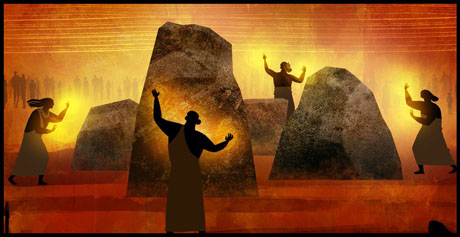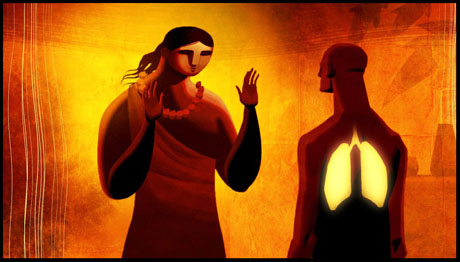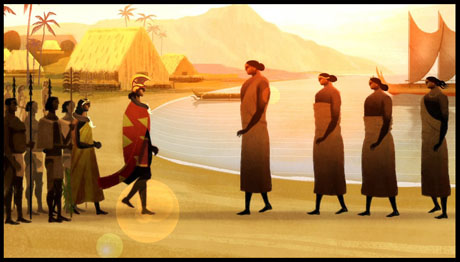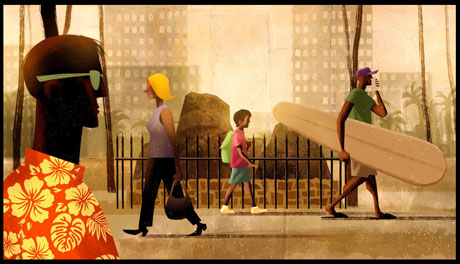
Kapaemahu has been making waves across the festival circuit, picking up several major honors. Now this animated short from Hawaii, about four extraordinary mahu and the stones that have honored them for hundreds of years, is vying for Annie and Oscar consideration. Directors Hinaleimoana Wong-Kalu, Joe Wilson and Dean Hamer have poured themselves into the powerful story and beautiful visuals of Kapaemahu.
Jackson Murphy: Why was this the right time for you all to share this story with the world?
Dean Hamer: We actually started this project almost 10 years ago. We were filming a documentary with Hina about her life as a teacher and prominent cultural person in Hawaii. We were down in Waikiki filming and she pointed to these stones and said, “Do you know what these are about?” And then she started doing a chant towards them. Of course we had no idea about the stones but as we learned the story about what they represented and how they represented Hawaiian concepts of healing that are so useful now and diversity and gender, we thought that this is such a great story and that we should develop it into a film. It took 10 years to do the research and then another couple years to do the animation. We didn’t know that we would be launching the film at the beginning of an infectious disease pandemic that is really all about healing and healers. It turned out to be a very important time for this story to be better known.

JM: And how has the incredible festival run made this difficult year feel special for you?
Hinaleimoana Wong-Kalu: It’s made me feel even more thankful and far more blessed. So many are experiencing their hardship, whether it be a loss of their means of sustainability of loss of their family or loved one, myself included. To be able to see where this initial response has gone is absolutely heartwarming and uplifting because that’s exactly what we set out to do. One project at a time – one person at a time. If we can just help one more person, just by putting our story out there, then it’s all worth it.
JM: I think this story is going to move a lot of people, not only visually but with its purposes. Dean, you mentioned 10 years of research. Joe, can you add to that about the discoveries you made?
Joe Wilson: Once Hina revealed this hidden history to us about this prominent stone monument on Waikiki Beach, it set us off on a course of trying to learn more about this history – first of all what the story is and why it has been hidden. And one of the most amazing aspects of this research journey was finding the first recorded version of what had been oral history in written form in the archives at the University of Hawaii, where it had been conveyed by someone of Hawaiian nobility back in the early 1900s. Once we found this written manuscript, we knew we had the template for the way we would tell this story. Through the voice of Hina’s narration and the animation that brings it to life in a way we think helps people who will be seeing it now see and hear it as it may have been conveyed by Hawaiians centuries ago.
JM: A standout element of it is the time jump near the end and then a progression of time montage of the stones that’s really well done. How was it putting together and what does that element mean to you?
HWK: In terms of what we’ve managed to pull together, it represents to me several things. Perhaps metaphorically, resilience, and stones communicate longevity and resilience… and endurance. Everything about the project because it focuses on these stones when we look at other stone monolith kinds of places around the world, like Stonehenge. They are enduring for generations. So are the stories. Everything we’ve managed to pull together and represent, that’s what comes to my mind.

JW: The first section of the film is the full telling of this history of the stones and the healers that came from Tahiti to Hawaii to bring the healing arts. And then the second and final portion of the animation is a visual reference to what happened in Hawaii and the stones as foreigners arrived and a transformation took place that ended up suppressing Hawaiian language and culture. And you see that in the form of the rise of Waikiki, in particular, where the stones were located as a mecca for tourism and development. That is what Hina is referencing. These stones, despite all of that, in this visual representation of them disappearing under a bowling alley in Waikiki, they survived. In this moment that we’re living in, it’s time for that story to be brought back to life. The world right now is really struggling with what it has meant for so many people’s stories, histories and understandings of themselves to have been hidden and misrepresented for so long. We think it’s a real opportunity to show that it’s time for all of these stories to be told and lifted up again so there can be broad healing… everywhere.
JM: Yes. This makes you think about human connection in really nice ways.
DH: What I have seen are groups of people including myself… who are either misrepresented or not represented at all in the media. I remember growing up as a kid on the east coast and never seeing myself represented as a Gay person in the media, except maybe in a show on the news about how horrible homosexuals were and it was a crime for them to be there. Whenever a person looks at the TV… or whatever the media is of the day and doesn’t see themselves represented, it’s like you looked in the mirror and didn’t see yourself. It’s kind of horrible. I see this story as a representation of Mahu and even native healers who aren’t represented, and that’s been really important to try to bring that alive.
JM: I’m glad you’ve been able to do that, and I think that’s why it has connected with so many people.

JW: Part of the way the Corporation for Public Broadcasting and PBS work is to ensure that voices of marginalized and misrepresented communities are given the opportunity to tell their stories. Here in Honolulu, there’s an organization called Pacific Islanders in Communication, which receives funding from the CPB to provide to independent storytellers like us – like Hina – to bring these kinds of stories forward. Without their support, the kind of work that we have been doing over the past 10 years with Hina and others simply wouldn’t have been possible. It’s essential and they’re supporting and mentoring a range of storytellers here in Hawaii and across the Pacific to do this kind of work.
JM: That’s great. Hina, with what you’ve been able to do with Joe and Dean, have you helped the Hawaii film scene blossom?
HWK: I believe that, first and foremost, even beyond helping the Hawaii film scene, it’s got to be something that contributes to a healthy Hawaii. For me, a healthy Hawaii starts with healthy Kanaka, Hawaiian people. Our islands are beautiful, undoubtedly, and the film industry here relies heavily upon not only the beauty of our islands but the people who are here to make a difference and give it that touch that will reflect Hawaii. Yes, I believe our project has contributed to supporting the film industry but in a couple of different ways. By helping to contribute to our Hawaiian people and honoring and uplifting stories of our land and places, like the place of the stones, Kapaemahu. And the more our story is touted about and honored, the more we uplift our film industry.
JM: And Kapaemahu has such glowing animation throughout.
HWK: Yes, this glow reflects several things. The initial understanding was that it had to reflect the aesthetics of traditional tuppercloth and colorings. That imagery is so well conveyed in the visual glow. When it comes to the topic that we’re presenting of healing, it goes hand in hand because that glow is life. That glow is… the heartbeat of life. And the healers bring this bright light – they bring knowledge and the skills to heal. Throughout the movie, that’s what we have been able to capture in the project. I’m really thankful.

JW: Daniel Sousa is our animation director. He’s done some extraordinary work. His animated short Feral was nominated for an Oscar several years ago and that’s what caught our eye. He loves working to help visualize stories of myth and legend in ways that really capture people’s hearts and minds. He worked closely with us and with Hina to translate what she was describing – the Hawaiian aesthetic seen in art forms here – into the visual aesthetic of the film.
DH: It wasn’t an easy thing because of course there isn’t a body of work to look at because people weren’t animating 1,000 years ago. And most of these stories that have been told in animation have been done in the style that comes out of Hollywood or Disney, which is great for those, but they’re not rooted in Polynesia at all. Daniel did an amazing job of imagining a style that would feel right. All of the Hawaiians that we talk to say this feels like Polynesia to them. That’s a very high mark of skill and honor for Daniel, so we’re very happy.
JM: This is a distinct short not only in look but also in the themes and messages. With the Annies and the Oscars on the way, what would it mean to you to be on those ballots?
DW: It would be amazing. For Joe and I as relatively new filmmakers it would be a big advance. But I think most of all it would represent something for Hawaiian filmmaking that would feel like a real contribution to us. There have been very few Hawaiian films up for these types of awards – made in Hawaii by people living in Hawaii with Hawaiian themes in collaboration with the Hawaiian people.
JW: What has been happening in the U.S. mainstream media landscape is a long overdue reckoning of representation and inclusion. There’s a long way to go but Kapaemahu and many other films that are circulating now are helping to challenge the way people see the kind of stories that need to be recognized and consumed.
HWK: As honored as I am and would be for our work to receive the highest of public awards, what’s most important to me is that my people and islands, the history, language and culture that I come from, is uplifted. There’s nothing more important to me than that. And it will be so for any project that I do. Our project could receive no award at all, but the award would come from the people that we help and the people that we uplift. It just gets catapulted into the highest place in the sky when it receives an award.
- INTERVIEW: Jeff Fowler On “Knuckles” And “Sonic 3” - April 22, 2024
- INTERVIEW: “Inside Out 2” Director And Producer On Pixar Sequel - April 16, 2024
- INTERVIEW: “Puffin Rock And The New Friends” And 25 Years Of Cartoon Saloon - April 10, 2024


 January 14th, 2021
January 14th, 2021  Jackson Murphy
Jackson Murphy  Posted in
Posted in  Tags:
Tags: 






